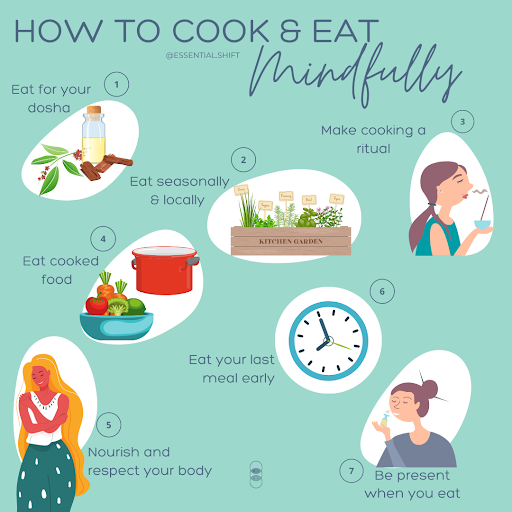Food and Ayurveda - An Overview
We all see food as a fuel for our body. We know what “good” food is and we have been educated on what we should or shouldn’t eat. But are you mindful when you eat?
Do you actually think about the food you eat when you are eating it? Well, there are more factors that come into play than just the nutritional value of your food, which of course is very important. But, did you know Ayurveda and food are closely linked?
Ayurveda which can be translated as “the science of life” describes “ayur”, or “life” as made up of four parts. These parts consist of the physical body, the mind, the soul and the senses (sight, hearing, touch, smell and taste).
Ayurveda looks at these four aspects of life and doesn't focus on one as we may in a traditional Western model.
So we will focus on the good as Ayurveda can support digestion, the immune system by bringing awareness to the awareness, mindfulness you bring into the food you gather, cook and eat. Ayurvedic eating takes into account intention, time of day, the season, the cooking and dining space, etc. In this article we will cover all the basics.
Ayurveda, the elements and food
As part of the human anatomy, in Ayurveda, it all starts with the five elements. These elements are known as air, fire, water, earth and space (or ‘ether’). These elements work to create three compounds that influence specific functions and energy in the body (mainly movement, transformation and cohesion).
As these compounds (known as doshas) are in alignment and work in balance, a person will experience a smooth moving processes of digestion, circulation, proper elimination of body waste, clear senses and overall happiness.
With a link back to the five elements, these manifest and are felt in the body once a person pays close attention to it. For example, the air and space give off cold and light, fire is sharp and hot and the earth and water are moist and heavy.
If there's too much or too little of one element, this can be experienced in the body as an imbalance. If you are experiencing something like dry skin, it could be from having too much dry or light foods in your diet. If you introduce some heavy and moist foods, this can help the problem.
Ayurveda is all about managing the imbalance that is introduced from having too much or too little of the elements in your life (and of course food).
Recommendation: The Everyday Ayurveda Cookbook from Kate O’Donnell. Also if you are looking to go deeper in your ayurvedic practice, read more in my articles all about your doshas OR join my FREE challenge “Align with the Elements”.
How food and Ayurveda is linked
In Ayurveda, humans are recognised as being microcosms (a small part) of the macrocosm (the big picture or universe). Our human body is made up of all the elements that also make up everything else. We are moved by the same energy that moves the ocean, wind, planets and stars. There is the cycle of the sun, the moon, tides and seasons, as do we. With the addition of artificial light, food transportation and our busy lives and it means nature's rhythm can often be out of alignment to us.
If we are eating out of season fruit all year round, staying up late and breathe in recycled air, the organism that is ourselves, becomes out of whack.
When it comes to Ayurveda, digestion plays a very important role. The digestion and absorption of food nutrients makes up the building block of our body - which is known as ahara rasa. Good digestion of food allows our body to glow consciously. Once you become aware of the food you eat and how it makes you feel, this is building a connection. Connecting to the gut and the body.
Food and the benefits on memory
As Maya Tiwari (Mother Maya), says “Food is memory. Eating is remembering”. When we eat food, it helps us to remember moments in our lives.
For me eating Ratatouille reminds me of my grandmother or how the Galette des rois (a French tradition) is all about coming together as a family and sharing a special moment.
The French expression ‘madeleine de Proust’ describes this perfectly. As mentioned in this article, “A madeleine de Proust is an expression used to describe smells, tastes, sounds or any sensations reminding you of your childhood or simply bringing back emotional memories from a long time”.
What do you remember from certain foods? This memory will often connect as to culture and family. When we eat and it takes us to a moment in our life, it brings us a range of emotions and connects us to what meal is in front of us.
To enhance this, when food is prepared with love and awareness, it enhances our positive energy and connects us to the people in our company and the earth. If you practice sadhana with food, this also allows you to be present to the food that is being prepared.
Setting up your kitchen in Sadhana
As we mentioned in the introduction blog to Ayurveda, Sadhana means conscious spiritual practice in Sanskrit. Sadhana is a conscious everyday activity that replicates the sacred in nature and so brings us in harmony with the great cycles of the cosmos.
With Sadhana in the kitchen, it will see us grind spices, prepare food while chanting and open ourselves up to a beautiful level of gratitude. When we prepare the food in the sadhana way, it teaches us to live simply and with love.
So setting up your kitchen in Sadhana, can look a little like this:
Avoiding loads of kitchen gadgets and tools. Using the best-quality utensils, pots and pans that fill you up with joy. For me, I use my Thermomix and Le Creuset, great quality pans.
Chanting as you prepare food - or even playing chant music in the kitchen. You can even say a blessing when you serve the food.
Using a sharp knife in the kitchen. In ancient vedic, a teaching suggests that a sharp knife is good for preparing food and also cutting through the negative emotions, so your food is then filled with love.
Also, you might want to avoid pungents like onions, garlic, strong chilli and coffee. This will help keep your food and mind pure.
It is all about simplicity and being mindful of how you prepare food in the kitchen.
Honoring your food - why and how you eat is important
Why we eat plays an important role in the relationship we have with food and our body. When we use food as medicine and have an intention for the food to nourish our body - it makes for good health.
How we eat the food also is an important factor. When you feel stressed and eat a wonderful, healthy meal - it will still have a negative impact on your body. IF you engage the senses and be mindful of the food you eat, it allows you to be fully present and often those stresses drift away - like a meditation.
The 7 food practices to try
If you want to start being mindful around the food you eat, here are some actions you can take to really start honouring the food and your body.
Eat seasonally & locally
Eat cooked food (allow the external to break down your food so the internal doesn’t have to work so hard)
Do not eat a main meal too late in the day before sleeping (go back to the article on the Ayurvedic clock and respect that)
Make eating and cooking a ritual or sadhana by chanting or being intentional
Nourish and respect your body
Eat for your dosha (check out the blog on doshas)
How you eat is as important as what you eat (be mindful when you are eating)
Knowing your body and knowing what foods your body needs through Ayurveda. Understanding your constitution (your doshas), will help you make more educated choices moving forward.
Final thoughts
Start exploring your relationship with food. Not just the food you eat, but how you eat it. How you prepare your food and even what time of the day you eat certain food.
Work on mindfully eating and be curious when your body responds to certain foods. In later articles, we will go deeper into the Agni (digestive fire), Ama (toxicity or waste in the body) & Ojas (immunity) and Gunas.


